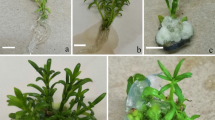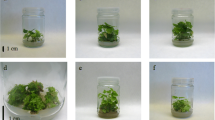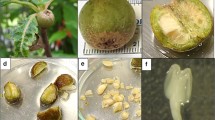Abstract
Murashige and Skoog’s (MS) basal medium with benzylaminopurine (BA), kinetin (KN), zeatin (Z), and thidiazuron (TDZ) were tested for induction of multiple shoots from mature-tree-derived axillary meristems of Pongamia pinnata. Sprouting of buds was 64% on medium devoid of plant growth regulators (PGR). Incorporation of BA, KN, or Z was ineffective in enhancing sprouting frequency or induction of multiple shoots. Sprouting was completely suppressed in the presence of TDZ. Caulogenic buds appeared in nodal meristems of these explants after withdrawal of TDZ. The number of shoot buds was more on explants precultured in higher concentrations. At higher concentrations of this PGR, a swelling developed at the axil. Multiple shoot primordia appeared and differentiated from this swelling after culturing these explants on MS medium for six passages of 2 wk each. Shoots were harvested and cultured on 0.45 μM TDZ for further proliferation. Primary explants after harvesting of shoots were identified as ‘stump’. Reculturing of stumps on 0.45 μM TDZ produced more shoots. This step was followed for six cycles to obtain additional shoots in each cycle. Shoots maintained on 0.45 μM TDZ elongated and rooted (70%) on growth regulator-free medium. Rooted shoots (65%) survived transfer to a sand/soil mixture. This report describes the protocol for micropropagation of P. pinnata using mature-tree-derived nodal meristems. Recycling of mature stock to produce a stream of useable shoots for subculturing and eventual stabilization is of great value and can possibly be generalized as an isolation protocol especially for woody species. Repeated proliferation of caulogenic buds from the same origin may also find application in rescue of endangered germplasm.

Similar content being viewed by others
References
Augustine, A. C.; D’Souza, L. Micropropagation of an endangered forest tree Zanthoxylum rhetsa Roxb. Phytomorphology 47(3):319–323; 1997.
Chalupa, V. Large scale micropropagation of Quercus robur L., using adenine-type cytokinins and thidiazuron to stimulate shoot proliferation. Biol. Plant. (Praha) 30:414–421; 1988.
Council of Scientific and Industrial Research. The Wealth of India—raw materials, vol.3. CSIR Publication, New Delhi; 1988:206–211.
Huetteman, C. A.; Preece, J. E. Thidiazuron: a potent cytokinin for woody plant tissue culture. Plant Cell Tissue Organ Cult. 33:105–119; 1993.
Joshi, M. V.; Sahasrabudhe, N. A.; Hazra, S. Responses of peanut somatic embryos to thidiazuron. Biol. Plant. 46:187–192; 2003.
Lu, C. Y. The use of thidiazuron in tissue culture. In Vitro Cell. Dev. Biol. Plant 29:92–96; 1993.
Mehta, U. J.; Barreto, S. M.; Hazra, S. Effect of Thidiazuron in germinating tamarind seedlings. In Vitro Cell. Dev. Biol. Plant 40:279–283; 2004.
Mehta, U. J.; Sahasrabudhe, N.; Hazra, S. Thidiazuron-induced morphogenesis in tamarind seedlings. In Vitro Cell. Dev. Biol. Plant 41:240–243; 2005.
Murashige, T.; Skoog, F. A revised medium for rapid growth and bioassays with tobacco tissue culture. Physiol. Plant. 15:42–46; 1962.
Murthy, B. N. S.; Murch, S. J.; Saxena, P. K. Thidiazuron: a potent regulator of in vitro plant morphogenesis. In Vitro Cell. Dev. Biol. Plant 34: 267–272; 1988.
Parmar, B. S.; Sahrawat, K. L.; Mukerje, S. K. Pongamia glabra: constituents and uses. J. Sci. Ind. Res. 35:608–611; 1976.
Pradhan, C.; Kar, S.; Pattnaik, P. K.; Chand, P. K. Propagation of Dalbergia sissoo Roxb. Through in vitro shoot proliferation from cotyledonary nodes. Plant Cell Rep. 18:122–126; 1998.
Srinivasa, U. Power to the people! Electricity from seeds! Pongam oil a diesel substitute. 1997. http://www.goodnewsindia.com/Pages/content/discovery/honge.html.
Sujatha, K.; Hazra S. In Vitro regeneration of Pongamia pinnata. Pierre. J. Plant Biotechnol. 33:263–270; 2006.
Upreti, J.; Dhar, U. Micropropagation of Bauhinia vahlii Wight & Arnott—a leguminous liana. Plant Cell Rep. 16:250–254; 1996.
Vivek, Gupta, A. K. Biodiesel production from karanja oil. J. Sci. Ind. Res. 63:39–47; 2004.
Acknowledgement
We acknowledge CSIR, India for the Research fellowship awarded to K. Sujatha.
Author information
Authors and Affiliations
Corresponding author
Additional information
Editor: B.M. Reed
Rights and permissions
About this article
Cite this article
Sujatha, K., Hazra, S. Micropropagation of mature Pongamia pinnata Pierre. In Vitro Cell.Dev.Biol.-Plant 43, 608–613 (2007). https://doi.org/10.1007/s11627-007-9049-2
Received:
Accepted:
Published:
Issue Date:
DOI: https://doi.org/10.1007/s11627-007-9049-2




